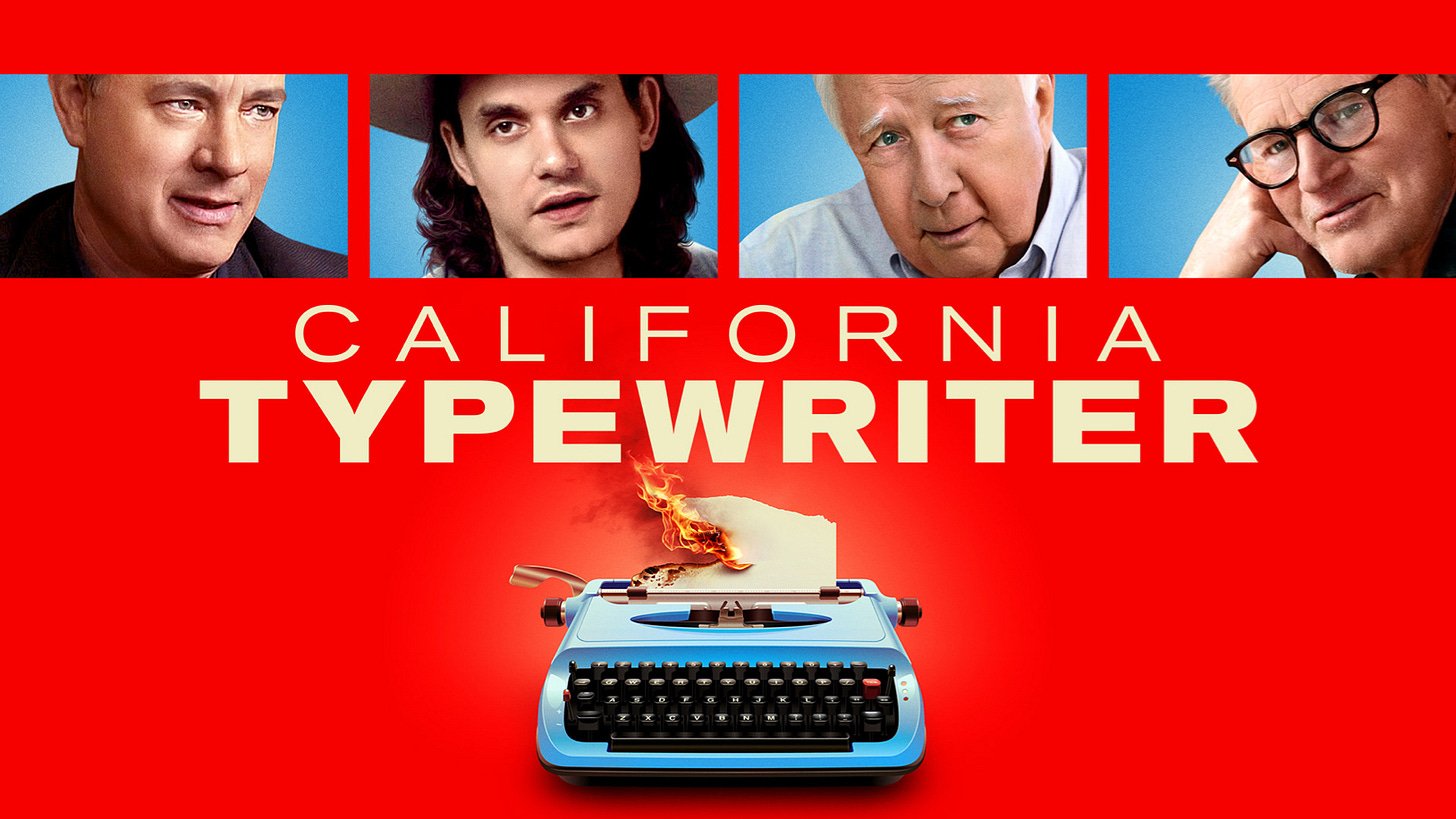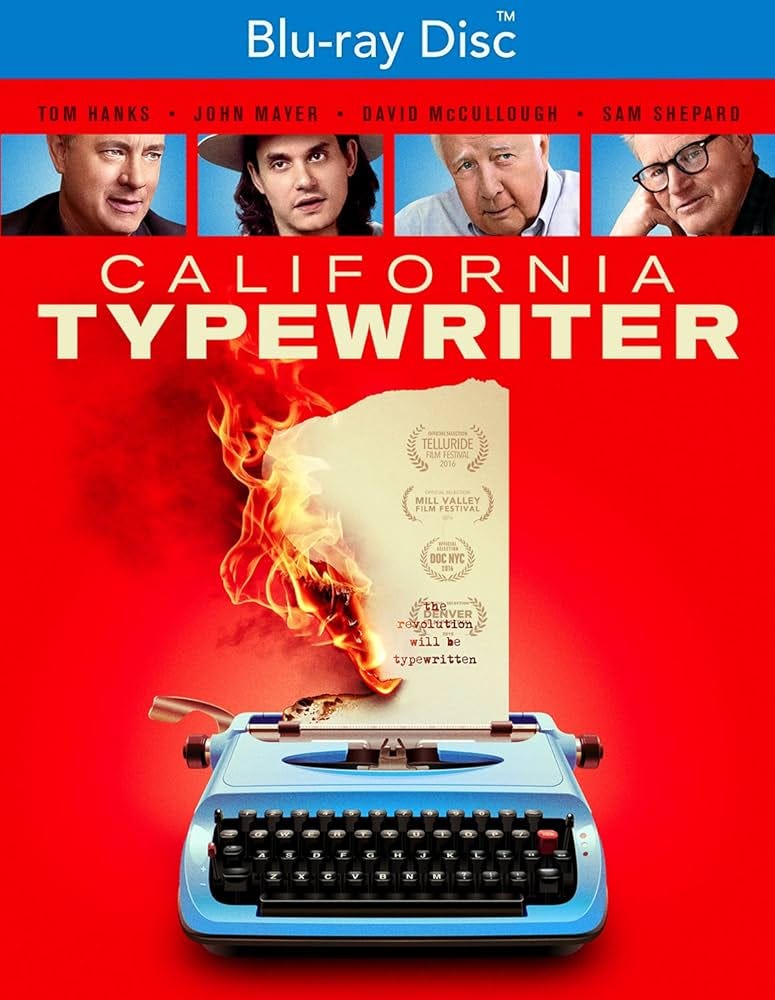I came across this gem of a documentary. It’s Doug Nichol’s California Typewriter (2016), and it’s all about, well — it’s all about typewriters. And the obsessives who collect them and deal in them. And use them. And it’s strangely touching.
For collectors, old typewriters are big business. Notable enthusiasts include Tom Hanks, who owns more than 250 typewriters. His collection is not just for show; he uses them. Hanks is a connoisseur, seduced by the solid mechanics, the tactile experience, the evocative ‘clack’ of finger hitting key. Hanks waxes lyrical, enthusing on the difference in sound between a dependable Smith Corona (‘soft muted’) or the report of an Olympia (‘crisp solid’). Even the names of the old machines have a poetry about them, the brand names which roll off the tongue: the Smith-Corona Sterling, the Standard, the Skywriter, the Clipper, the Galaxy, the Super Silent…
Typewriters. They’re so alluring. One of the most significant inventions of the 19th century; an invention which also helped to liberate women in the workplace. The mechanism, the feel of the keys, that tactile ‘clackety-clack’ sound, the evocative smell of oil, ink and burnt metal. And so thinks the splendidly named Herb Permillon, former IBM repairman and owner of California Typewriter, the typewriter repair shop he ran in Berkeley, California, and around which the documentary is based. Or that should have been in the past tense, as sadly Herb died in 2022, following the closure of his business (despite the publicity brought by the documentary) two years earlier. For Herb, it’s a labour of love as he fights a losing battle in the new digital age despite a new generation of steampunks, creatives and hipsters discovering the charm of mechanical type.
Futurologists so often get it wrong. By now, we were all supposed to be running around in Bacofoil space suits, driving Dan Dare Space Cars in the sky and serving dehydrated, vacuum-packed delicacies at our Martian dinner parties. What happened? Despite the Pot Noodle, I’m still wearing more-or-less 20th century clothes, and our petrol-driven car is very much attached, alas, to the road and sometimes breaks down. But despite the beards, I’m very much with the rebellious hipsters — with their appreciation of ‘vinyl’ (as they call it, bless ‘em), their ‘Lomography’ (i.e. cheap film cameras), their ‘craft’ gins (distilled in Victorian copper), their arty little Super 8 films — and their Olivetti Valentine typewriters, designed by Ettore Sottsass. Even if they have to package everything up in marketing speak. But look at the success of books! Remember the sinister Kindle? When the wise and good gravely informed us that the printed, physical book was kaput, a thing of the past? Well, they got that one wrong, did they not? I understand that today, more books are being published than ever before? Although the pulp paperback — the sun-tan-lotion-splattered-beach-read — may have been replaced by the Kindle, the book has been reinvented as a luxury object: the lovely printing quality — and design — of children’s illustrated non-fiction, for instance, is streets ahead of anything done in the 1990s.
And I’m also a fully paid up member of Richard Polt’s Typewriter Revolution (2015), at least in spirit, if not in practice:
We assert our right to resist the Paradigm,
to rebel against the Information Regime,
to escape the Date Stream…
We choose the real over representation,
the physical over the digital,
the durable over the unsustainable
the self-sufficient over the efficient.
THE REVOLUTION WILL BE TYPEWRITTEN
For unlike the internet, you’ve got something tangible to keep at the end of it all. This is going to be a headache for future historians. I mean, do you archive your emails or delete them? It’s almost impossible to believe now, but at the age of thirteen, at boarding school, I sat down every week and wrote letters to my parents, my sister, and various friends imprisoned in other institutions. In ink. On paper. Compare that to the one-fingered, illiterate text!
And the documentary revival has been a very good thing, too. This idea that the punters might actually pay to see a documentary at the cinema. As a film, California Typewriter (2016) is beautifully put together and beautifully photographed, altho’ ironically, it appears to have been shot on digital film. But that is the future of analogue. To work hand-in-hand with the digital: the Lomography craze, after all, owes its considerable and deserved success to the internet.
I watched California Typewriter (2016) via Amazon Prime Video digital download, and it’s also available on DVD and Blu-ray, as pictured below. It was, I think, the third cinematic documentary we have covered so far on WEEKEND FLICKS, at least since The London Nobody Knows (1967) — and looking ahead, we need to find more of them to write about. Maybe something psychogeographical? Iain Sinclair’s London Orbital (2002) or Patrick Keiller’s London (1994)?
You’ve just been reading a free post — available to all. It’s hard to believe now, but that was Film No. 140 in the WEEKEND FLICKS. Cinema for Grown Ups archive. And here’s a quick word about the paid subscription, which costs £5 a month or £50 a year. Paid subscribers get their own special post on Friday mornings, special additional posts and access to the entire archive. The Sunday morning posts are free and can be read by anybody and everybody. I hope you enjoy California Typewriter (2016) as much as I did. It’s a rather beautiful film. Wistful and poignant.









I lived through the transition at the departments of State and Defense as typewriters were replaced by MagCard machines and Wang word processors (“never confuse a Wang with technology” said one IT guru). This included demonstrating how the agonizing weeklong overtime layered process of preparing a briefing book for the Secretary of Defense could be done in 3 regular workdays by half the people. Of course, this was before they fully recognized the opportunity to endlessly replace “happy” with “glad” and then back again. I’ve long argued that the IBM Selectric III with the self correcting ribbon was the true high point in government word processing tech. Just enough labor saving capacity without over empowering the editors.
There's a Substack to be written on this theme for sure, Luke. We can even suggest a name:
"The Analog"